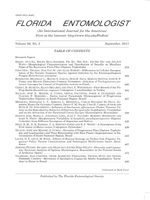The pit-prop beetle, Hexarthrum exiguum (Boheman), is reported for the first time from Turkey where a population was found colonizing skirting boards (baseboards) in Istanbul. The feeding of adults and larvae caused the skirting boards to disintegrate.
Hexarthrum exiguum (Boheman, 1838) is known as the pit-prop beetle in central Europe, where it damages wet wood, mostly in mines but also in houses (Hickin 1963). This species is distributed from central Europe to Caucasia occurring on wood products and hardwood trees including Norway maple (Acer platanoides L.), horse chestnut (Aesculus hippocastanum L.), sweet chestnut (Castanea sativa Mill.), nettle tree (Celtis australis L.), hawthorn (Crataegus monogyna Jacq.), beech (Fagus spp.), Prunus spp., oak (Quercus spp.), lime (Tilia spp.) and elm (Ulmus spp.) (Reitter 1916; Hoffmann 1954; Folwaczny 1983; Heijerman 1993; Wanat 1999; Hellrigl 2006, Whitehead 2006).
There is no previous evidence of Hexarthrum exiguum occurring in Turkey (e.g., Schimitschek 1944); and we now add this species to the entomofauna of Turkey.
MATERIALS AND METHODS
A survey was carried out to find the causes of disintegration of skirting boards (baseboards) constructed of Middle Density Fiberboard (MDF) in a house in the Kemerburgaz district of Istanbul Province 12 Jul 2010. In a basement, we observed small piles of fresh wood-dust around the skirting boards (Fig. 1). Adult beetles were collected from the infested areas and were placed in killing jars primed with ethyl acetate.
RESULTS AND DISCUSSION
Genus Hexarthrum Wollaston
Hexarthrum Wollaston, Ann. Mag. Nat. Hist., (3) 5, p. 448, 1860; Voss, Mitt. Münchn. Ent. Ges., 44/45, pp. 233 & 235, 1955.
All adult specimens were identified as a Cossoninae, Hexarthrum exiguum (Fig. 2). They are uniformly chestnut-brown in color and cylindrical, and have a typical broad-nosed appearance with a straight short rostrum and compact clubbed antennae. The rostrum is slightly longer than wide and is longer than the head. The scrobes reach the lower edge of the eyes and originate a little before the middle of the rostrum. The eyes are flat, legs and antennae reddish brown in color and antennae relatively short and glabrous. The funicle has six antennomeres, the first being equal in length to the second and third together but wider than all the others; the second to sixth antennomeres are clearly wider than long and very compact. The pronotum is tumid, longer than the rostrum and longer than wide, rounded at sides and covered in flat-bottomed pits (Fig. 2). These pits are contiguous at the lateral margins and the pleuron but not on the pronotal disc. The parallel elytral striae are composed of rows of regular more or less equidistant symmetrical pits. The interstriae, of similar width to the striae, are finely punctate and occasionally strigulate.
Infestations of this beetle are facilitated by high humidity (see Fig. 3). This observation is similar to that reported in the literature by Hoffmann (1954) and Hellrigl (2006). There are no detailed studies that evaluate the effects of Hexarthrum species and their potential relationships with fungi. It is therefore difficult to reach a conclusion about the likely economic consequences of damage caused by this genus. It is interesting to observe that H. exiguum is here not only synanthropic (see Whitehead 2006) but is also colonizing a synthetic reconstituted wood-based building material. Further attempts should be made to locate and identify H. exiguum elsewhere in Turkey.








